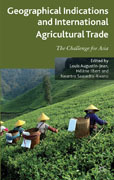
Geographical indications and international agricultural trade: the challenge for Asia
Augustin-Jean, Louis
Ilbert, Hélène
Saavedra-Rivano, Neantro
Food safety issues and economic growth have boosted the demand for quality food in Asian countries. In this context, the existence of traditional products with a long history has caused a proliferation of new geographical indicationssuch as the famous Chinese longjing tea or Japanese sake. These products havethe potential to promote local development and gain access to international markets, but this potential can only be realized through globally harmonized legislation and intellectual property rights, also advocated by the WTO. This has stimulated debate over how the quality of these goods is defined and how this affects their demand. This book uses a combination of theoretical discussionand empirical fieldwork to answer these questions, and analyse the local and global impact of the proliferation of GIs. INDICE: The Globalization of Geographical Indications: The Challenge for Asia.PART I: THE THEORETICAL IMPLICATIONS OF PRODUCTS OF ORIGINS.Geographical Indications and International Trade.Are Foodmarkets Special Markets?.Standardization vs. Products of Origins.The Multidimensional Definition of Quality.Products with Denominations of Origin and Intellectual Property Rights: The International Bargaining Process.The Concept of Terrior as the Basis of Corporate Strategy in Agribusiness .PART II: ASIAN CHALLENGES.From Products of Origin to Geographical Indications in Japan.The Development of Geographical Standards for Sake in Japan.An Export Niche in the Philippines.Geographical Indication and Industrial Organization of Food Market in China.Terrior and Green Tea in China.
- ISBN: 978-0-230-35575-0
- Editorial: Palgrave Macmillan
- Encuadernacion: Cartoné
- Páginas: 280
- Fecha Publicación: 17/08/2012
- Nº Volúmenes: 1
- Idioma: Desconocido
